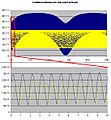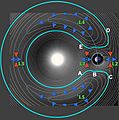3753 Cruithne facts for kids

Earth and Cruithne's orbit
|
|
| Orbital characteristics | |
|---|---|
|
Average orbital speed
|
27.73km/s |
| Inclination | 19.81° |
| Satellite of | Earth |
| Physical characteristics | |
| Circumference | ~5km (equatorial) |
|
Mean density
|
2g g/cm³ |
| 1.622 m/s² (0.165 4 g) | |
| 2.38 km/s | |
|
Sidereal rotation period
|
27.321 582 d (synchronous) |
|
Equatorial rotation velocity
|
4.627 m/s |
| 1.542 4° (to ecliptic) 6.687° (to orbit plane) |
|
| Albedo | 0.12 |
3753 Cruithne is a small space rock called an asteroid. It has a very unusual orbit around the Sun. Because of its path, it sometimes seems to follow Earth. This is why some people call it "Earth's second moon." However, Cruithne does not actually orbit Earth. It orbits the Sun, just like Earth does.
Contents
How was Cruithne discovered?
3753 Cruithne was first found on October 10, 1986. It was discovered by Duncan Waldron. He used the UK Schmidt Telescope in Australia. Later, in 1997, scientists figured out its strange orbit. These scientists were Paul Wiegert, Kimmo Innanen, and Seppo Mikkola. The asteroid is named after the Cruithne, an ancient group of people from Ireland.
How big is Cruithne?
3753 Cruithne is about 5 kilometres (3.1 miles) wide. That's roughly the size of a small town! From 1994 to 2015, Cruithne came closest to Earth every November. Scientists believe there is no risk of it hitting Earth for millions of years. This is because its path around the Sun does not cross Earth's path.
Cruithne's unique orbit
Cruithne travels around the Sun in an oval-shaped path, just like Earth. It takes about 364 days to go around the Sun. This is almost the same amount of time Earth takes. Because of this, Cruithne and Earth seem to follow each other.
Why is it called a "horseshoe orbit"?
From Earth's point of view, Cruithne's path looks like a kidney bean or a horseshoe. It moves slightly ahead of Earth. It takes a little less than a year to complete this "bean" shape. Each year, Earth "falls behind" the bean a bit more. This makes the path look like a slow spiral moving away from Earth.
After many years, Earth will have fallen far enough behind. Then, Cruithne will start to "catch up" to Earth from behind. When it finally catches up, Cruithne will pass close to Earth several times. Earth's gravity will then gently change Cruithne's orbit. This will make Cruithne take a little more than a year to orbit the Sun. The "kidney bean" shape will then start to move away from Earth in the other direction.
The next time Cruithne will have many close approaches to Earth is around the year 2292. In July of that year, it will come within about 12.5 million kilometres of Earth.
How does the orbit pattern repeat?
This whole pattern repeats every 380 to 390 years. The kidney-bean-shaped orbit comes back towards Earth from the other side. Earth's gravity then changes Cruithne's orbit again. This makes its trip around the Sun slightly less than a year once more. This last happened around 1902 and will happen again around 2676.
Other objects with similar orbits
Scientists have found other space objects that have orbits similar to Cruithne's. These include asteroids like 54509 YORP and 2002 AA29.
Some moons also have horseshoe orbits. For example, Janus and Epimetheus are moons of Saturn. Their orbits around Saturn are simpler than Cruithne's, but they work in a similar way.
Other planets also have "co-orbital" objects. Mars has four asteroids that share its orbit. Jupiter has many more, called Trojan asteroids. Saturn also has small moons that share orbits with larger moons. However, these objects do not follow horseshoe orbits like Cruithne.
Images for kids
-
Cruithne and Earth seem to follow each other because of a 1:1 orbital resonance.
See also
 In Spanish: (3753) Cruithne para niños
In Spanish: (3753) Cruithne para niños







